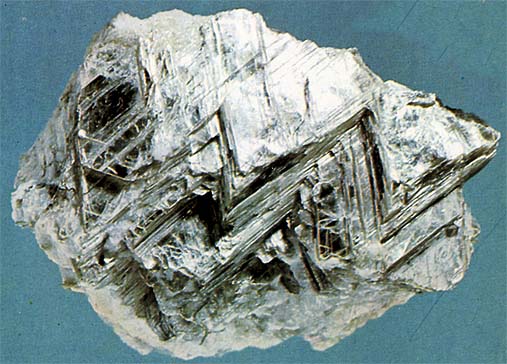Mica (silicates): Muscovite
 Diagnostic Card.
Diagnostic Card.
In the photo - pseudohexagonal muscovite (Henry North, Carolina State). Below: fuksita crystals, chromium-containing muscovite difference.
K Al 2 (OH, F) 2 Al Si 3 O 10
Crystal system monoclinic
2.5 Hardness
Specific weight 2,76-2,88
Cleavage is perfect
fracture splintery
Color is colorless and gray
Color white powder
luster pearl

Muscovite - potassium mica. In the old days was known as "the glass of Muscovy." Aluminosilicate. Luster pearl, sometimes silver, metallovidny (in common parlance - "silver cat"). The thin transparent scales. Colour: slightly yellowish, greenish or pinkish to colorless. The bar is white. Cleavage very perfect. It is easy to bend, elastic. Heat-resistant and acid-resistant. It is very resistant to weathering.
A very common mineral. The crystals are rare. For the most part represented by lamellar precipitates with irregular contours or unit mi. It is used as in electrical insulation material. Distributed everywhere. Deposits associated with pegmatites. In the CIS, a well-formed crystals are found in Karelia, Siberia, in the Urals.
Muscovite crystals tabular, and the face of the prism is sometimes furrowed deep horizontal hatching. Also clear crystals, muscovite is often found in the form of flakes scattered among the rocks, or packages foliated plates, thickness and width of which are very variable. The mineral is easily split along the cleavage, giving individual flexible and elastic lamina.
A typical muscovite is colorless or colored in various shades of gray. This coloring gives the mineral, especially when combined with pearlescent predominant characteristic silvery appearance.
Paragon is a mica, muscovite completely similar, but with the substitution of sodium potassium. This series also belong glauconite (glandular mica with sodium, potassium and calcium), and celadonite roscoelite.
Chemical composition. potassium oxide (K2O), 11.8% alumina (Al2O3) 38.5%, silicon dioxide (SiO2) 45,2%, water (H2O) 4.5%; Green chromium muscovite with an admixture of trivalent chromium oxide (Cr2O3) .nazyvaetsya fuksitom (chrome muscovite), thick scaly unit is called sericite.
Form crystals. Tabular, plate, short-columnar pseudohexagonal. Structure. The layered lattice. Class symmetry. Prismatic - 2 / m. Cleavage. Perfect on the basis (001). Aggregates. The solid, thick scaly mass accumulation spherulites.


Diagnostic features.
It does not dissolve in acids and melted with difficulty. It melts with difficulty; thereby forming a gray or yellow glass pearls. Behavior in acids. It does not dissolve at a temperature above 850 o C, the loss of water.
Origin.
Common mineral, especially in granites, pegmatites gras-magnetic, schist, gneiss and other metamorphic rocks. In the form of fine silvery scales widespread in sands and sandstones.
Deposits and application.
In Italy, good specimens come from pegmatite Monesheno, Ossola; Peony from pegmatites of Lake Como; of alpine living in some gneisses (Bacheno, villadossola and Premia, Piedmont region, in Valle Aurina, South Tyrol region). In Europe, it is common in Norway, Sweden, Austria and Switzerland. Muscovite is the best thermal insulation and an electrically insulating material
Varieties.
Fuchs - chromium muscovite distributed in the form of green mass. Fuchs (chrome mica combination). The emerald-green variety of muscovite, rare.
Sericite - tonkocheshuychataya or dense variety of muscovite. Silky luster, sometimes bright apple-green color (in this case resembles talc).

Muscovite from the North. Karelia in the mica window of the XVII century. Photo: © AA Evseev.
- Gatchell - "New Almadén snag" - arsenide and antimony sulfide (modern sulphosalts)
- Antimony - toxic metal (semi-metal) are widely used in industry, medicine and engineering
- Zirconium - a rare and non- metal and dangerous jewel in the oxide and salts
- Gold - yellow dangerous and toxic metal -date and accurate digital cable technology
- Sulphur - a golden-yellow toxic substance and a sign of volcanic activity
- Cadmium - a toxic uncirculated unknown wide range of people silvery metal
- Lead - a poisonous gray simulator silver metal and toxic metal snag
- Arsenic - poison classic medieval and modern poisoners and medicine in medicine
Toxic and hazardous radioactive rocks and minerals
** - Poisonous stones and minerals (obligatory check in chemical laboratory + clear indication of toxicity)
** - Radioactive rocks and minerals (obligatory check on a regular dosimeter + ban on the open sale of radioactivity in the event of more than 24 mR / hour + additional measures to protect the population)
Catalog minerals and gems in groups of the world
** - Poisonous stones and minerals
** - Radioactive rocks and minerals


Comments
Commenting, keep in mind that the content and the tone of your messages can hurt the feelings of real people, show respect and tolerance to his interlocutors, even if you do not share their opinion, your behavior in terms of freedom of speech and anonymity offered by the Internet, is changing not only virtual, but real world. All comments are hidden from the index, spam control.